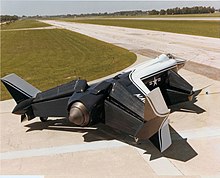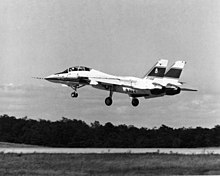
The turbofan or fanjet is a type of airbreathing jet engine that is widely used in aircraft propulsion. The word "turbofan" is a combination of the preceding generation engine technology of the turbojet, and a reference to the additional fan stage added. It consists of a gas turbine engine which achieves mechanical energy from combustion, and a ducted fan that uses the mechanical energy from the gas turbine to force air rearwards. Thus, whereas all the air taken in by a turbojet passes through the combustion chamber and turbines, in a turbofan some of that air bypasses these components. A turbofan thus can be thought of as a turbojet being used to drive a ducted fan, with both of these contributing to the thrust.
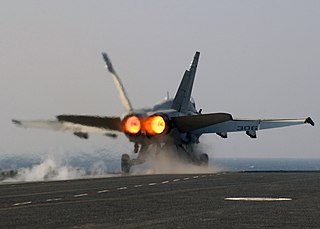
An afterburner is an additional combustion component used on some jet engines, mostly those on military supersonic aircraft. Its purpose is to increase thrust, usually for supersonic flight, takeoff, and combat. The afterburning process injects additional fuel into a combustor in the jet pipe behind the turbine, "reheating" the exhaust gas. Afterburning significantly increases thrust as an alternative to using a bigger engine with its attendant weight penalty, but at the cost of increased fuel consumption which limits its use to short periods. This aircraft application of "reheat" contrasts with the meaning and implementation of "reheat" applicable to gas turbines driving electrical generators and which reduces fuel consumption.

The Rolls-Royce Spey is a low-bypass turbofan engine originally designed and manufactured by Rolls-Royce that has been in widespread service for over 40 years. A co-development version of the Spey between Rolls-Royce and Allison in the 1960s is the Allison TF41.

The General Electric F110 is an afterburning turbofan jet engine produced by GE Aerospace. It was derived from the General Electric F101 as an alternative engine to the Pratt & Whitney F100 for powering tactical fighter aircraft, with the F-16C Fighting Falcon and F-14A+/B Tomcat being the initial platforms; the F110 would eventually power new F-15 Eagle variants as well. The engine is also built by IHI Corporation in Japan, TUSAŞ Engine Industries (TEI) in Turkey, and Samsung Techwin in South Korea as part of licensing agreements.
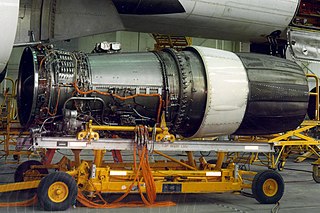
The General Electric F101 is an afterburning turbofan jet engine. It powers the Rockwell B-1 Lancer strategic bomber fleet of the USAF. In full afterburner it produces a thrust of more than 30,000 pounds-force (130 kN). The F101 was GE's first turbofan with an afterburner.

The Pratt & Whitney F119, company designation PW5000, is an afterburning turbofan engine developed by Pratt & Whitney for the Advanced Tactical Fighter (ATF) program, which resulted in the Lockheed Martin F-22 Raptor. The engine delivers thrust in the 35,000 lbf (156 kN) class and was designed for sustained supersonic flight without afterburners, or supercruise. Delivering almost 22% more thrust with 40% fewer parts than its F100 predecessor, the F119 allows the F-22 to achieve supercruise speeds of up to Mach 1.8. The F119's nozzles incorporate thrust vectoring that enable them to direct the engine thrust ±20° in the pitch axis to give the F-22 enhanced maneuverability.

The Pratt & Whitney F135 is an afterburning turbofan developed for the Lockheed Martin F-35 Lightning II, a single-engine strike fighter. It has two variants; a Conventional Take-Off and Landing (CTOL) variant used in the F-35A and F-35C, and a two-cycle Short Take-Off Vertical Landing (STOVL) variant used in the F-35B that includes a forward lift fan. The first production engines were delivered in 2009.

The Pratt & Whitney J58 is an American jet engine that powered the Lockheed A-12, and subsequently the YF-12 and the SR-71 aircraft. It was an afterburning turbojet engine with a unique compressor bleed to the afterburner that gave increased thrust at high speeds. Because of the wide speed range of the aircraft, the engine needed two modes of operation to take it from stationary on the ground to 2,000 mph (3,200 km/h) at altitude. It was a conventional afterburning turbojet for take-off and acceleration to Mach 2 and then used permanent compressor bleed to the afterburner above Mach 2. The way the engine worked at cruise led it to be described as "acting like a turboramjet". It has also been described as a turboramjet based on incorrect statements describing the turbomachinery as being completely bypassed.

The Pratt & Whitney TF30 is a military low-bypass turbofan engine originally designed by Pratt & Whitney for the subsonic F6D Missileer fleet defense fighter, but this project was cancelled. It was later adapted with an afterburner for supersonic designs, and in this form it was the world's first production afterburning turbofan, going on to power the F-111 and the F-14A Tomcat, as well as being used in early versions of the A-7 Corsair II without an afterburner. First flight of the TF30 was in 1964 and production continued until 1986.

The Pratt & Whitney F100 is an afterburning turbofan engine designed and manufactured by Pratt & Whitney to power the U.S. Air Force's "FX" initiated in 1965, which became the F-15 Eagle. The engine was to be developed in tandem with the F401 which shares a similar core but with the fan upscaled for the U.S. Navy's F-14 Tomcat, although the F401 was later abandoned due to costs and reliability issues. The F100 would also power the F-16 Fighting Falcon for the Air Force's Lightweight Fighter (LWF) program.

The Pratt & Whitney J57 is an axial-flow turbojet engine developed by Pratt & Whitney in the early 1950s. The J57 was the first 10,000 lbf (45 kN) thrust class engine in the United States. The J57/JT3C was developed into the J52 turbojet, the J75/JT4A turbojet, the JT3D/TF33 turbofan, and the XT57 turboprop. The J57 and JT3C saw extensive use on fighter jets, jetliners, and bombers for many decades.
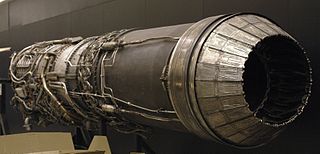
The General Electric J79 is an axial-flow turbojet engine built for use in a variety of fighter and bomber aircraft and a supersonic cruise missile. The J79 was produced by General Electric Aircraft Engines in the United States, and under license by several other companies worldwide. Among its major uses was the Lockheed F-104 Starfighter, Convair B-58 Hustler, McDonnell Douglas F-4 Phantom II, North American A-5 Vigilante and IAI Kfir.

The General Electric F404 and F412 are a family of afterburning turbofan engines in the 10,500–19,000 lbf (47–85 kN) class. The series is produced by GE Aerospace. Partners include Volvo Aero, which builds the RM12 variant. The F404 was developed into the larger F414 turbofan, as well as the experimental GE36 civil propfan.
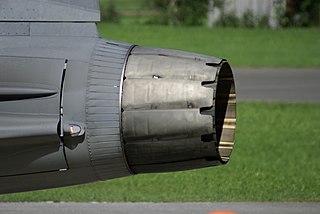
Reaktionsmotor 12 (RM12) is a low-bypass afterburning turbofan jet engine developed for the Saab JAS 39 Gripen fighter. A version of the General Electric F404, the RM12 was produced by Volvo Aero. The last of the 254 engines was produced on 24 May 2011, at which time it had reached 160,000 flight hours without any serious incidents.
The General Electric F118 is a non-afterburning turbofan engine produced by GE Aviation, and is derived from the General Electric F110 afterburning turbofan.

The Pratt & Whitney PW1120 turbofan is a derivative of the F100 turbofan. It was installed as a modification to a single F-4E fighter jet, and powered the canceled IAI Lavi.

The Saturn AL-31 is a family of axial flow turbofan engines, developed by the Lyulka design bureau in the Soviet Union, now NPO Saturn in Russia, originally as a 12.5-tonne powerplant for the Sukhoi Su-27 long range air superiority fighter. The AL-31 currently powers the Su-27 family of combat aircraft and some variants of the Chengdu J-10 multirole jet fighter. Assembly of the engine is also performed under license in India by HAL, for the Sukhoi Su-30MKI. Improved variants power the fifth-generation Sukhoi Su-57 and Chengdu J-20.
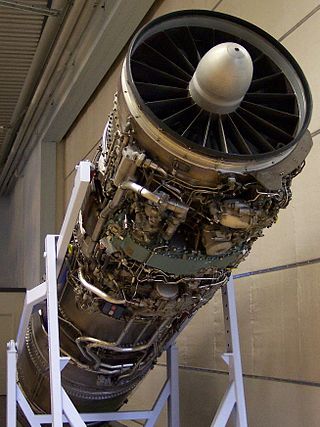
The Volvo RM8 is a low-bypass afterburning turbofan jet engine developed for the Saab 37 Viggen fighter. An augmented bypass engine was required to give both better fuel consumption at cruise speeds and higher thrust boosting for its short take-off requirement than would be possible using a turbojet. In 1962, the civil Pratt & Whitney JT8D engine, as used for airliners such as the Boeing 727, was chosen as the only engine available which could be modified to meet the Viggen requirements. The RM8 was a licensed-built version of the JT8D, but extensively modified for supersonic speeds, with a Swedish-designed afterburner, and was produced by Svenska Flygmotor.

The Vought/General Dynamics Model 1600 series was a fighter aircraft proposal designed for the United States Navy's Navy Air Combat Fighter (NACF) program. The Model 1600 was a carrier-based derivative of the General Dynamics F-16 Fighting Falcon, but lost to the Northrop/McDonnell Douglas F/A-18 Hornet.
The Klimov VK-3 was the first Soviet afterburning bypass turbojet engine. Designed by S V Lyunevich at Klimov, at OKB-117 in 1949, this engine first ran in 1952, and was qualified at 5,730 kg (12,632 lb) thrust (dry) and 8,440 kg (18,607 lb) thrust in 1954. The VK-3 was developed for the Mikoyan-Gurevich I-3 (I-380) and I-3U/I-5 (I-410) fighters. First flown in the I-3U in July 1956, the engine's performances was good but its reliability was poor. Even after modifications in December 1956 when newly designed compressor blades were installed, developmental problems continued, the program was ultimately canceled in January 1958. The engine was superseded by the Lyulka AL-7F, a less modern but more efficient engine.

